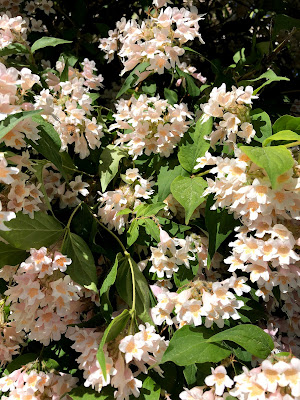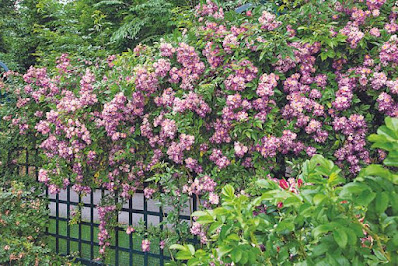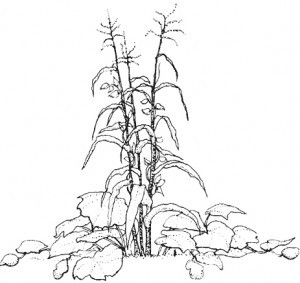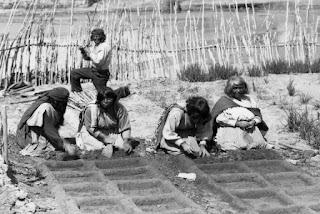November in the Garden
By Patti O’Neal
Jefferson County
The year is winding down, and for the most part, so are our
gardens. There are still many tasks that
can be accomplished. Some of us are just
done for the year and want everything cleaned up and ready for next year, while
others of us continue to push the limits of our gardens to produce yet more.
Either way, there are things that can still be done to care
for our gardens, tools and wildlife.
The weather has been beautiful this fall, so I hope you have
been watering your trees and shrubs and any newly planted perennials to get
them stored up for winter. As weather
may fluctuate going forward, remember to get the hose out at least once a month
and give trees and shrubs a drink on lovely days when the temps are above 50
degrees and the ground is not frozen. Water
at the dripline for the most benefit to the tree.
Apply tree wrap to young trees that may be positioned in
your landscape to be harmed by flash freezes and cold temperatures. Use appropriate material designed for this
purpose. Wrap well, over-lapping the paper
or fabric about two thirds up the trunk.
Remember to remove the wrap mid to late April depending on weather. Then wrap again next fall if needed.
If you have not yet cleaned up all your leaves, use a
mulching mower and go over them and let the small pieces mulch the lawn.
If by any chance you still have piles, mow
over them and use to mulch your flower beds with them, add to compost, mix into
your vegetable garden beds, store a few bags for next summer when carbon
material is harder to come by or if you have used all you can, donate them to a
local urban farmer who will use them to regenerate their soil for the coming year.
Remember to leave some leaf litter in some
strategic out of the way places for the native insects to overwinter safely.
Likewise, don’t clean it up too early, before
egg hatch or you will throw the wonderful creatures away before they can hatch and begin to protect your landscape.
Providing water is the single most important thing you can
do for native insects and birds as well.
Place a bird bath where a heater designed for this task can be plugged
in to keep the bath from freezing over. This
will give you much pleasure to watch them drinking and bathing during the next
months. In addition, don’t be too quick
to cut down perennials that go to seed.
This is a rich food source for native birds as well as shelter for
native insects for the winter. If you
enjoy birds, providing a rich source of fat starting as soon as possible (if
you have not already) in the form of suet and rich seeds in squirrel proof
feeders will encourage birds that do not migrate to enjoy your yard.

Don’t put your tools away untended. Now is the time to give them a good scraping
of caked on soil with a wire brush then soap and water on the blades, taking
them apart if possible to clean more thoroughly and drying well. Use 00
fine steel wool to clean any rust from the metal surfaces and linseed oil to
rub into the wooden handles.
Hang long
handled tools off the floor if possible to keep humidity from the metal parts
and you can store hand tools in a bucket of sand with a small amount of linseed
oil to keep them from rusting. Pruners
should be taken apart if possible, cleaned and sharpened and re-assembled and
stored in a dry place.
There is still time to plant bulbs if you have not gotten them
in the ground yet. The actual chill
requiredfor bulbs is approximately 16 weeks and we haven’t even had that yet
this year, so keep planting flowerbulbs and garlic if you want. Then mulch them in well so they do not heave
when the temperatures finally do drop.
Make sure you have the proper season extension materials for
any vegetable crops or sensitive plants that will need to be covered for frost
protection. Horticulture fabric, often
referred to as frost blankets, can be found at nurseries and big box
stores. This fabric is designed to take
any moisture and not harm the plants, unlike sheets and other household fabrics
that hold water, will lie on the plant material and cause it to freeze rather
than protect it. It is helpful if there
is a structure over the plants with which you can support this material to keep
it off the plants and hold in any warmth the soil may have acquired during the
day when the sun is out.

If you have potted plants you have not gotten into the ground
yet, here is a way to winter them over if you do not have time before the
temperatures drop or you haven’t yet decided where you want to put them. You can dig a hole in the ground and plant
the pot and all up to the rim of the pot and winter them over that way. Water and mulch and they can be planted next
spring when you have allotted more time.
I love to use the large pots I plant my lettuce crops in once I have
emptied them of my fall lettuces. If you
are a raised bed or in-ground vegetable gardner think of this as well. The
ground is already soft and so much easier to get them in successfully. That way you do not loose them to
procrastination!
Store your crops appropriately. If you have grown vegetables to enjoy over the winter months there are some key techniques you should know. Not all crops require the same humidity or temperatures to hold successfully. Make sure you have the proper storage areas for the various crops you want to hold over. Of course, thinking of this earlier in the year, like when you were planting them, would help to inform which of those crops you could hold over most successfully, or give you time to construct or purchase items to help you store them. But there are still ways to find the most appropriate place in your home or shed or garage, that can host your crops to make them hold for the longest the most safely. Consult the fact sheets below for charts and tips to help you get the best storage with the most flavor and nutrients from your crops.

Work never seems to end in the garden. But I wouldn’t have it any other way. Soon the last of my fall crops will be done,
except for the spinaches, leeks, carrots and chard that I keep going right up
until Christmas. They only get sweeter
with a hit or two of frost, so they are easy to keep. Then the catalogues start arriving and the
dreaming portion of my gardening year begins again. Happy Gardening!
Further Reading : The following fact sheets will give you
additional information on completing the tasks mentioned above with evidenced
based research from CSU and other universities.
“Fall and Winter Watering,”
https://extension.colostate.edu/topic-areas/yard-garden/fall-and-winter-watering-7-211/
“It’s Time To Wrap Your Trees,” http://csuhort.blogspot.com/2016/11/its-time-to-wrap-your-trees.html
“Winter Tool Care,” https://mgnv.org/2018/12/19/winter-tool-care/
“Frost Protection and Extending the Growing Season,” https://cmg.extension.colostate.edu/Gardennotes/722.pdf
“Storing Vegetables at Home,” https://nchfp.uga.edu/how/store/wisc_vegetables.pdf
“Storage of Home Grown Vegetables,” https://extension.colostate.edu/topic-areas/yard-garden/storage-of-home-grown-vegetables-7-601/





































